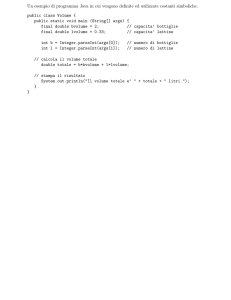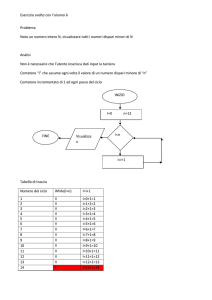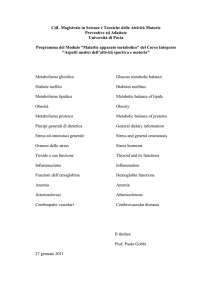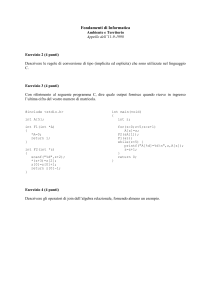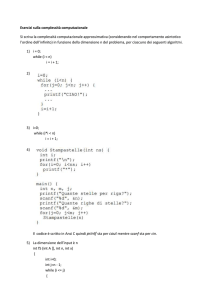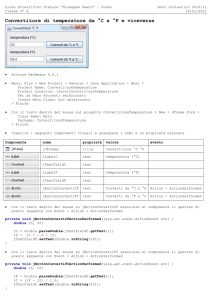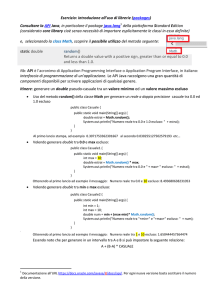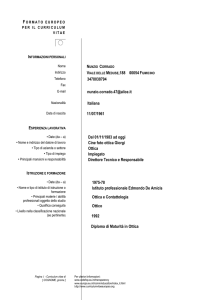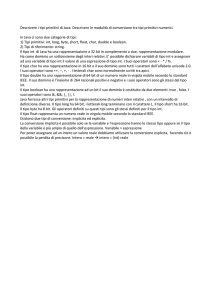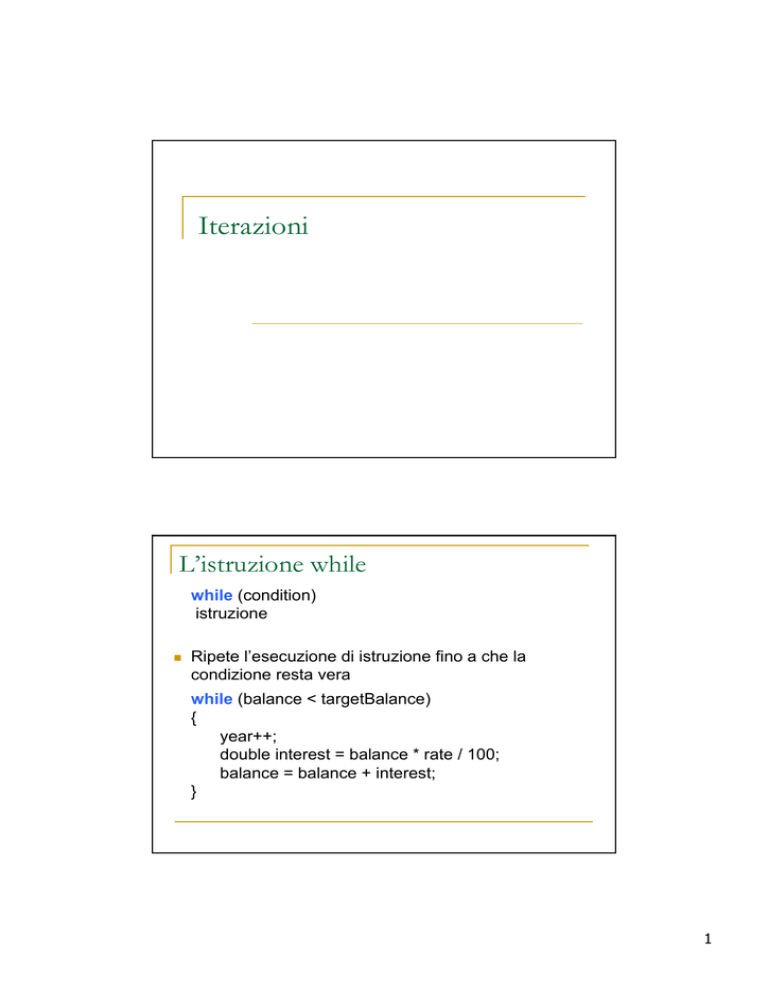
Iterazioni
L’istruzione while
while (condition)
istruzione
Ripete l’esecuzione di istruzione fino a che la
condizione resta vera
while (balance < targetBalance)
{
year++;
double interest = balance * rate / 100;
balance = balance + interest;
}
1
Diagramma di flusso per il ciclo while
File Investment.java
public class Investment {
public Investment(double
aBalance, double aRate) {
balance = aBalance;
rate = aRate;
years = 0;
}
public double getBalance() {
return balance;
}
//accumula interessi fino a che il target è
raggiunto
public void waitForBalance(double
targetBalance) {
while (balance < targetBalance) {
years++;
double interest =
balance * rate / 100;
balance = balance + interest;
}
}
public int getYears() {
return years;
}
private double balance;
private double rate;
private int years;
}
2
Errori comuni: I loop infiniti
1.
while (year < 20) {
balance = balance + balance * rate / 100;
}
2.
while (year > 0) {
year++;
}
L’istruzione do/while
Esegue il corpo del ciclo almeno una volta:
do
istruzione
while (condition);
Esempio:
double value;
do
{
String input = console.readLine();
value = Integer.parseInt(input);
} while (input <= 0);
3
Daigramma di flusso per do Loop
L’istruzione for
for (initialization; condition; update)
istruzione
Esempio:
for (int i = 1; i <= n; i++)
{
double interest = balance * rate / 100;
balance = balance + interest;
}
Equivalente a
Initializzazione;
while (condizione) {
istruzione; update; }
4
Diagramma di flusso ciclo for
Esempio
Aggiungiamo alla classe Investment il metodo
waitYears che accumula gli interessi corrispondenti
ad un certo numero di anni
public void waitYears(int n)
{
for (int i = 1; i <= n; i++)
{
double interest = balance * rate / 100;
balance = balance + interest;
}
years = years + n;
}
5
Loop innestati
•
Esempio: stampiamo il triangolo
[]
[][]
[][][]
…
[][][][]
n righe
for (int i = 1; i <= n; i++)
{
// forma una riga del triangolo
for (int j = 1; j <= i; j++)
r = r + "[]";
r = r + "\n";
}
Es.: lettura ciclica input (test interno)
import java.io.*;
public class SommaInput{
public static void main(String[] args) throws IOException {
double somma=0;
InputStreamReader reader = new InputStreamReader(System.in);
BufferedReader console = new BufferedReader(reader);
boolean done = false;
while (!done) {
String input = console.readLine();
if (input.length() == 0)
done = true;
else {
double x = Double.parseDouble(input);
somma+=x;
}
}
System.out.println("la somma e`:"+ somma);
}
}
6
Es.: lettura ciclica input (test inizio)
import java.io.*;
public class SommaInput{
public static void main(String[] args) throws IOException {
double somma=0;
String input;
InputStreamReader reader = new InputStreamReader(System.in);
BufferedReader console = new BufferedReader(reader);
while ((input = console.readLine()).length() != 0) {
double x = Double.parseDouble(input);
somma+=x;
}
System.out.println("la somma e`:"+ somma);
}
}
I token
La classe StringTokenizer può scomporre una stringa nei suoi elementi
(token)
I token sono separati da spaziature (spazi, tab, e caratteri per andare a
capo)
Esempio: "4.3 7 -2" e` scomposta in tre token: "4.3", "7", "-2"
StringTokenizer tokenizer = new StringTokenizer(input);
Crea uno StringTokenizer per la stringa input
E` possibile usare un separatore diverso indicandolo come secondo
argomento del costruttore
tokenizer.hasMoreTokens()
Restituisce true se ci sono altri token da estrarre e false altrimenti
tokenizer.nextToken()
restituisce il prossimo token
7
Esempio uso StringTokenizer
import java.util.StringTokenizer;
import java.io.*;
public class TokenTest {
public static void main(String[] args) throws IOException {
double somma=0;
String input;
InputStreamReader reader = new InputStreamReader(System.in);
BufferedReader console = new BufferedReader(reader);
input= console.readLine();
StringTokenizer tokenizer = new StringTokenizer(input);
while (tokenizer.hasMoreTokens()){
String token = tokenizer.nextToken();
double x = Double.parseDouble(token);
somma+=x;
}
System.out.println("la somma e`:"+ somma);
}
}
Scandire i caratteri di una stringa
s.charAt(i)
è l’ i-esimo carattere della
stringa s
for (int i = 0; i < s.length(); i++)
{
char c = s.charAt(i);
…
}
8
Esempio: un programma che conta le vocali
s.indexOf(ch) è l’indice della posizione in cui c
appare per la prima volta in s, o -1 se c non
appare in s
int NumVocali = 0;
String vocali = "aeiou";
for (int i = 0; i < s.length(); i++)
{
char c = s.charAt(i);
if (vocali.indexOf(c) >= 0)
NumVocali++;
}
Problema
Vogliamo costruire una classe Dado che
modella un dado che quando viene lanciato
cade a caso su uno dei suoi lati
9
Numeri casuali
La classe Random modella un
generatore di numeri casuali
Random generatore = new Random();
crea
int n = generatore.nextInt(a);
un generatore di numeri casuali
retituisce un intero n con 0 <= n < a
double x = generatore.nextDouble();
restitisce un double x con 0 <= x < 1
Esempio uso di Random
import java.util.Random;
public class Dado {
//costruttore che costruisce un dado
// con s facce
public Dado(int s) {
facce = s;
generatore = new Random();
}
public int lancia() {
return 1 +
generator.nextInt(facce);
}
private Random generator;
private int facce;
// Questo programma simula 10 lanci
del dado
public class TestaDado {
public static void main(String[]
args) {
Dado d = new Dado(6);
final int LANCI = 10;
for (int i = 1; i <= LANCI; i++) {
int n = d.lancia();
System.out.print(n + " ");
}
System.out.println();
}
}
}
10

